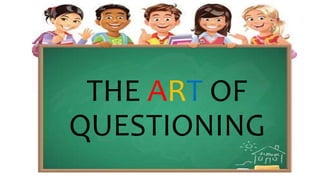
The Art of Questioning
- 2. How do you define question?
- 3. a QUESTION is any sentence which has interrogative form or function.
- 4. Good questioning is an excellent aid to teaching that is hardly utilized to the fullest extent. The quality of teachers’ questions affects the quality of thinking in the classroom.
- 6. Why do teachers ask questions? • to interest, engage and challenge the learners. • to check on prior knowledge • to stimulate recall and use of existing knowledge and experience in order to create new understanding and meaning; • to focus thinking on key concepts and issues: • to extend learners’ thinking from the concrete and factual to analytical and evaluative;
- 7. Why do teachers ask questions? • to lead learners to a planned sequence which progressively establishes key understandings. • to promote reasoning, problem solving evaluation and the formulation of hypotheses. • to promote learners’ thinking about the way they have learned; • to develop critical thinking skills and inquiring attitudes and reinforce student understanding: • to provide feedback and enliven classroom discussion;
- 8. Why do teachers ask questions? • to nurture insights by exposing new relationships; • to assess achievement of instructional goals and objectives; • to stimulate students to pursue knowledge on their own:
- 9. The purposes of asking a good questions are generally pursued in the context of classroom recitation, defined as a series of teacher questions, each drawing out a student response and sometimes a teacher reaction to that response.
- 11. • Distribute questions so that all, including non volunteers are involved. • Balance factual and thought provoking questions. • Ask both simple and challenging questions so that the poorer students may participate and the brighter students may be extended.
- 12. • Encourage lengthy responses and sustained answers. • Stimulate critical thinking. • Use the overhead technique. Question--Pause--Name
- 13. • Ensure audibility, then refuse to repeat the questions and answers. • If a student ask a question, don’t answer it until you’ve asked the class, “How would you answer that question?”. • Personalized questions. • Suggest partnership by inquiring.
- 17. FACTUAL QUESTIONS used to get information from the students and often test rote memory.
- 18. CLARIFICATION QUESTIONS intend to provide clarity to both students and teachers
- 19. BROADENING OR EXTENSION QUESTIONS enlarge the existing theme, explore implications if the response and can be useful in opening up further possibilities.
- 20. JUSTIFYING QUESTIONS probe for assumptions and explore reasons for particular answers
- 21. HYPOTHETICAL QUESTIONS used to explore students’ understanding of complex situations beyond the scope of a particular encounter by creating hypothetical scenarios.
- 22. QUESTIONS ABOUT QUESTIONS allow the students to verbalize their reasoning and understanding of the events leading to their own questions.
- 23. REDIRECTED QUESTIONS generate a wide variety of response and allow the students to evaluate each others contributions.
- 28. PROCEDURE: 1. To assess the types of questions asked, a video or audio tape recording of a class needs to be made. 2. As soon as possible after the class is over; watch and/or listen to the recording and choose a ten minute segment for analysis. 3. Write down in its entirely each question that you ask during this ten minute segment.
- 29. PROCEDURE: 4. As you go over these questions consider the following; a. what effects might your phrasing have had on the students’ thinking about question? b. How could you improve the wordings of these questions?
- 30. PROCEDURE: 5. Focus your attention on the amount and complexity of thinking required for your students to respond to each question. 6. Classify your questions using the Bloom’s Taxonomy categories. 7. Do the type of analysis periodically throughout the year to assess your progress.
- 31. EDUCATIONAL IMPLICATIONS: •This approach will help the students learn how to listen. •It will provide feedback on how successful the lesson was in stimulating their thought process.
- 32. EDUCATIONAL IMPLICATIONS: •The students will reflect on their learning through higher level thinking processes such as analysis, synthesis, comparison or summation.
- 33. EDUCATIONAL IMPLICATIONS: •Students are more likely to remember what they have learned when they explore the implications of their learning.
- 34. ACTIVITY
- 35. MECHANICS; Select a particular topic or issue and write down at least 6 questions that could be formulated out from the chosen topic. See to it that the questions are relevant to the needs and interest of the students. Criteria: Content 3 points Clarity of the question 1 point Relevance to the students’ needs 1 point ________ 5 pts/each
